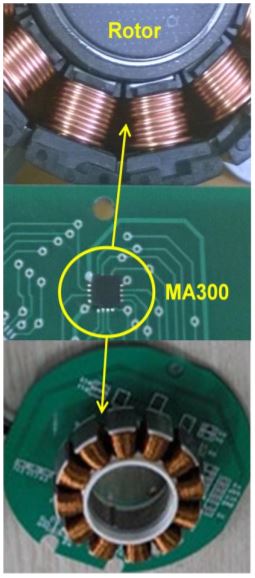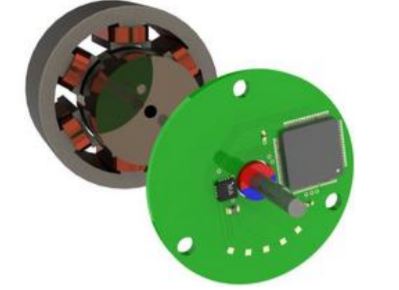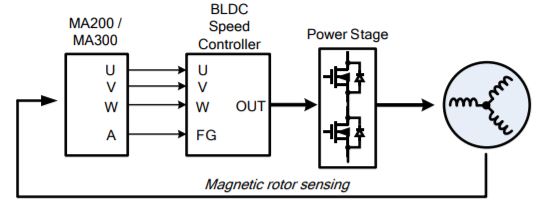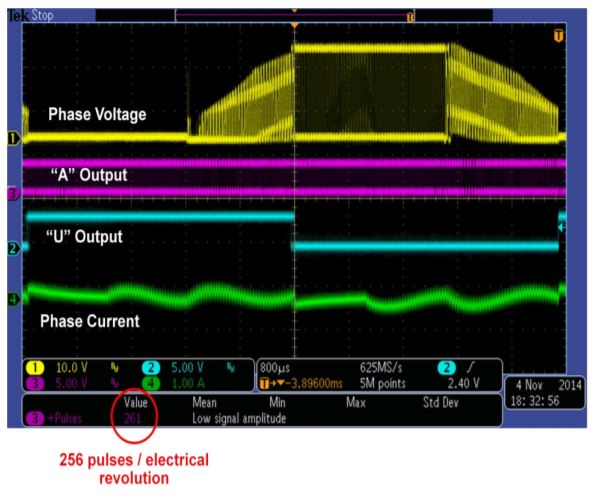下载 PDF 版本
应用说明
使用 MagAlpha™ 器件检测 BLDC 转子位置
简介
无刷直流 (BLDC) 电机或电子换向 (EC) 电机都需要向控制电子设备提供反馈,以指示电机转子的位置或角度。传统解决方案通常采用三个霍尔传感器来感测安装在转子上的磁体磁场,从而完成位置的反馈。这种反馈虽然提供了电机换向所需的信息,但其分辨率只能达到 60°。这个精度不足以测量转子的旋转位置或精确测量电机速度,尤其是在电机低速时。为了克服这些缺点,除了采用霍尔传感器,通常还会采用光学旋转编码器来提供较高的速度与位置精度,但这意味着要增加一个非常昂贵而且不太可靠的额外机电部件。MPS提供了一个更好的解决方案,利用安装在转子磁体附近的 Sensima MagAlpha™ 磁性角度传感器来直接感测转子的位置。
The MagAlpha™ 器件
The Sensima MagAlpha™ 是可以直接感测外部磁场角度的IC。该器件采用专有技术,能够以超高速度和高达 11 位的精度测量角度。角度信息可通过多种方式呈现,包括通过串行 (SPI) 端口直接读取角度。该器件还提供能够模拟光学编码器正交输出的输出,以及通常由 BLDC 电机中采用的三个霍尔传感器生成的“UVW”信号。磁性角度传感器通常与 IC 表面上方的 2 极磁体一起使用(如下图左侧所示)。此外,MagAlpha™ 器件还提供侧轴补偿功能,从而能够精准测量放置在器件侧面的磁体角度(如下图右侧所示)。
感测转子磁体
将 MagAlpha™ 器件安装在靠近转子一侧的位置可以测量转子磁场的角度,从而测得转子的机械角度。下图显示了一个 4 极转子周围的磁场,其中器件安装在距离转子很近的位置。从图中可以看出,随着转子的转动,穿过 MagAlpha™ 器件的磁场角度也会随之旋转。
与采用三个霍尔传感器时一样,传感器测量每对磁极的一整圈转动。换句话说,轴每机械转动一圈,器件就会报告每极对的一圈电气旋转;而这正是换向所需。优于许多同类设备的是, MagAlpha™ 传感器速度极快,它每 2 µS 计算一次位置,延迟为3 µS。这实现了超高转速下的精确换向,而 3 µS 延迟在 3kHz 电气频率(或 4 极电机大约 100,000 RPM)下导致的换向误差也仅为约1%。这实际上比许多简单的霍尔传感器还要快!
MagAlpha™ 器件的“零”角度位置是可编程的。在制造过程中,只需一个简单的校准步骤即可将转子置于一个已知位置并设置器件的零位置。设置数据存储在器件内部的非易失性存储器中,取代了光学编码器所需的劳动密集型手动定位。此外,该器件还允许提前对换向进行电气调整。
安装
BLDC 电机通常包含一个位于电机内部的 PCB板,用来安装霍尔传感器以及电机控制器/驱动器等。如果转子磁体结构足够靠近 PCB,则可以将 MagAlpha™ 器件直接安装在该 PCB 上,其位置类似于用于安装三个分立式霍尔传感器的位置。而且,MagAlpha™ 器件尺寸极小(3mm x 3mm x 0.9mm),通常可放置在磁极之间。下图所示为内转子和外转子电机中的 PCB 安装示例。
请注意,即使无法将 MagAlpha™ 器件安装在电机内部,通过在电机轴上安装单独的磁盘或磁环仍然可以发挥该器件的所有优势,如下图所示。
采用三个霍尔传感器实现换向时,传感器必须精准安装,否则将可能导致错误的换向,并带来转矩脉动和低效运行。而采用 MagAlpha™ 器件,仅在一个位置感测磁场角度。换向信号(始终恰好相隔 120°)在该角度生成,因此传感器的安装精确性并不像安装三个独立霍尔传感器那样重要。这改善了由于霍尔传感器位置错误造成的产量损失及返工。
MagAlpha™ 接口
MagAlpha™ 器件可模拟 UVW 霍尔信号直接输出信号,也可提供模拟光学编码器正交信号的输出。这些信号可直接替代霍尔传感器和光学编码器输出用于位置控制应用,或替代速度控制应用的 “FG” 或转速计信号。事实上,MagAlpha™ 器件可直接取代霍尔传感器和速度/位置编码器,同时仍可利用现有的电机控制器和驱动器电路,如下图所示。
利用 MagAlpha 提升现有控制器/驱动器性能
F为了获得更高的性能,也可使用微控制器通过 MagAlpha™ 器件的 SPI 接口直接读取转子的电角度(分辨率高达 11 位)。由于可实时获知极为精确的转子位置,因此,利用简单的查找表算法即可生成每个相位的 PWM 信号,这也简化了正弦换向的实现。
性能和成本优势
在位置控制应用中,MagAlpha™ 传感器能够以更低的成本提供与光学编码器相当或更佳的分辨率。此外,它对工业应用中的污垢和灰尘不敏感,而对光学编码器来说,这些因素常常导致位置检测错误并最终导致系统故障。在速度控制应用中,精确的角度测量可用于生成高脉冲计数转速计信号(每圈高达 256 个脉冲),如下图所示。这是大容量 BLDC 电机中常用的电磁转速计(“FG”)的 10-20 倍。
结语
Sensima MagAlpha™ 器件凭借其成本优势和性能优势,可用于替代 BLDC 电机中的霍尔传感器和光学编码器。该器件通常可直接安装在电机内部来检测转子位置,无需添加额外磁体。








直接登录
创建新帐号